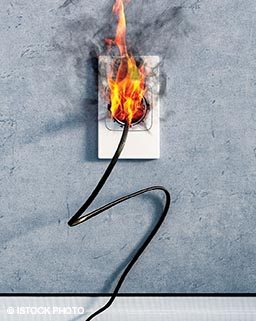Preventing fires is paramount, but we need to be prepared to deal with fire emergencies when they occur. A trained firefighter will advise us to get out quickly and leave the firefighting to those who are trained to do so. We do not always have this option, however, so learn what to have in place to ensure the safety of all.
Fire Extinguishers
Different types of fires require different kinds of extinguishers. Do a careful analysis of where fires are most likely to occur, and appropriately equip your business, filling station, workshop, boat, vehicle and perhaps even your dive site.
- Use water or foam to contain fires fueled by wood, paper, trash, textiles and other ordinary products.
- Use carbon dioxide, halon or foam where flammable liquids and gases are burning.
- Use carbon dioxide or dry powder for electrical fires.
- Use wet chemical (a soapy foam) for fires caused by cooking oils and fats in a kitchen.
Maintenance is also essential. You do not want to find yourself with an extinguisher that’s out of propellant gas or media, missing a nozzle, has a dislodged dip-tube or one that can’t be located when you need it most.
It’s important to have some training with using an extinguisher. Without it, you could get trapped, spread the fire or use the wrong extinguisher for the type of fire, resulting in a burn or possibly acceleration of the fire.
Preparation and Planning
Does the classroom in your dive shop have an emergency exit that will work when the room is dark and filled with smoke? Signage indicating where the extinguishers and emergency exit routes are located will save valuable time in containing a fire. Be sure to place extinguishers in strategic locations with escape routes behind them. A fire alarm, preferably connected to the local fire station or emergency services department, is paramount.
Ensure that your evacuation route is always kept clear. If there are changes to the building, furniture or hazardous areas, update your evacuation plan accordingly.
Emergency action plans are essential. Adhere to the following best practices:
- Where the fire is fast and spreading, evacuate and count heads.
- A small, containable fire can be managed using appropriate extinguishers and with training.
- If it is not possible to contain the fire, contain the area — close the doors to isolate the fire even if only temporarily, sound the alarm, get out, and stay out.
- Under no circumstances should anyone go back inside to rescue anyone or anything — you will place the firefighters in more danger.
- No plan is effective without realistic and regular drills.
Firefighters
Get to know your local firefighting service. Consult them for advice if you are unsure of best practices for fire safety preparation.
Fires can usually be prevented, prepared for and managed. The cost of being ready doesn’t measure up to potential losses or a fatality. Planning for a fire emergency will protect your staff and business investment.
© Penyelam Siaga — Q1 Winter 2019
